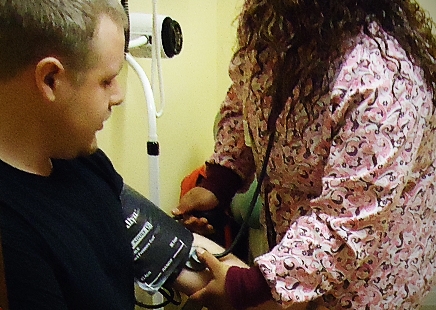Community Health Centers Care for Wave of Patients Stephen Harris, who was unable to afford health insurance when he could not work after a car accident, gets the health care he needs at OneWorld Health Centers in Omaha, Neb. (Photo by Haley Armstrong/OneWorld Health Centers) Recovery Act dollars helped the South Central Family Health Centers in Los Angeles expand clinic space and add doctors and nurses to provide health care for people hit hard by the recession. But by 7 a.m. most week days, there are still lines of people waiting to see a doctor or nurse. “If we doubled that funding and space, we’d still fill that up,” said Richard A. Veloz, the chief executive of South Central. Many of the Community Health Centers that have received Recovery Act assistance through Health Resources and Services Administration (HRSA) grant programs have served more new patients, including uninsured patients, than they originally said they would when they applied for the funds. South Central and other Community Health Centers discovered – to paraphrase the Kevin Costner movie “Field of Dreams” – if the health centers build it, they will come. Thirty Percent More Patients Served Than ExpectedThe target for new patients as of Dec. 31, 2010, was 2.56 million, but the Community Health Centers as a whole actually cared for more than 3.7 million new patients, more than 1.1 million additional patients than they had expected to serve. Of those 3.7 million new patients, more than 2.2 million were uninsured, surpassing the target of new uninsured patients by almost 1 million. The Recovery Act provided $500 million to HRSA’s Community Health Center Programs to support increased demand for services at existing and new service sites, and $1.5 billion for construction, renovation, health information technology (IT) and medical equipment. More than 1,100 centers received funding to make capital investments in new and existing sites and hire additional staff in order to care for more patients. These Federally Qualified Health Centers serve people regardless of their ability to pay or whether they have health insurance. “This was a ‘just in time’ investment as people across the nation lost jobs and consequently often lost their health insurance,” HRSA Administrator Mary Wakefield, Ph.D., R.N., said of the Recovery Act funds for Community Health Centers. “This provided a place for individuals and families to turn to for health care.” And when more patients showed up than they had expected because of the economic downturn, many of the Community Health Centers pushed their Recovery Act dollars to the limit, making changes in office hours and turning unused space into exam rooms, while new and existing staff worked overtime to handle the surge of people needing health care. South Central Family Health Centers Served 1,800 More PatientsIn the case of South Central, the health center had estimated that it would serve an additional 1,200 patients with its Increased Demand for Services (IDS) grant, all of whom would be uninsured. Instead, South Central is providing health services for an additional 1,848 new patients, Veloz said. By making staff changes to accommodate more walk-in patients, some small operational changes and increasing provider overtime hours, South Central was able to serve greater numbers of patients than it had projected it would with the Recovery Act funds. “Providers stayed a little longer. Lunches were shorter. It was a whole team effort,” said Genevieve Filmardirossian, South Central’s associate director and chief operations officer. South Central was awarded $1.3 million for establishment of a New Access Point (NAP), about $304,000 for IDS, and about $1.6 million for additional construction, renovation, equipment and health IT. With these funds, South Central was able to open a new facility in Huntington Park, add seven exam rooms, a room for mammography and radiology, and add staff at its main inner city Los Angeles site. In addition, with the IDS funds, South Central was able to hire two doctors to accommodate walk-in patients. Along with additional clinical and support staff hired with Recovery Act funds, South Central was able to extend weekday and Saturday hours. Alabama’s Franklin Primary Health Center Helped 9,000 MoreFranklin Primary Health Center Inc. in Mobile, Ala, faced the same surge of low-income and uninsured patients looking for health care that they could not afford. Franklin Primary received $710,000 in NAP funds for a new center in western Mobile County; $791,000 in IDS funds to increase service capacity; $1.4 million in Capital Improvement Program (CIP) funds for construction, renovation and equipment projects; and another $314,000 in CIP funds when it took over a health center in Baldwin County last fall. When Franklin Primary sought the IDS funds, it proposed providing health services for 2,040 new patients, of whom 1,635 would be uninsured. However, the Recovery Act funds actually allowed Franklin Primary to serve 9,067 additional patients as of Dec. 31, 2010, of whom 3,376 were uninsured. With NAP funds, Franklin Primary also was able to care for 1,678 new patients, of whom 762 were uninsured, at its new West Mobile Family Health Center. “This [IDS] money came right in time for us. … When we received the ARRA funds the recession was at its peak and people were just rolling in, so we exceeded our projections,” said Charles White, Franklin’s chief executive. “We were seeing new homeless folks, people who had lost their jobs and their homes.” Franklin Primary had lost nine physicians during 2007-2008 and able to replace only two in 2007. The remaining physicians were not replaced until 2009 when White recruited seven physicians and two dentists. With the IDS funds, he also was able to hire support staff for the new doctors, dentists and support staff to improve the capacity and efficiency of operations. At the Medical Mall, Franklin Primary’s main site, the Recovery Act construction and renovation funds allowed them to renovate new clinic space, providing 10 more exam rooms and three doctor offices, which allowed for three more primary care physicians. Another site, the Loxley Family Medical Center in Baldwin County, was “bursting out at the seams” with only three exam rooms, White said. The Recovery Act funds allowed it to add four new exam rooms, an additional nurses’ station and another doctor’s office. Recovery Act CIP funds have also allowed the center to add electronic health records. Nebraska’s OneWorld Community Health Centers Service Cared for 5,500 MoreAt OneWorld Community Health Centers, based in Omaha, Neb., officials had projected that Recovery Act assistance could help OneWorld care for 2,400 new patients, of whom 80 percent, or 1,920 patients, would be uninsured. Instead, as of Dec. 31, 2010, OneWorld provided health services for an additional 5,470 new patients, 3,626 of whom had no health insurance. The percentage of uninsured patients dropped to about 66 percent, reflecting an increase in patients who are children and covered by Medicaid. “Our demand is even beyond what we do,” said Andrea Skolkin, the chief executive. “A lot [of the patients] work but they don’t have health insurance.” OneWorld was there for people like Stephen Harris, 31, who became a patient after he injured his back in a car accident. Harris had no health insurance – he couldn’t afford his premiums when he was unable to continue working at a landscaping company, the Omaha World-Herald reported. Like all Community Health Centers, OneWorld charges uninsured patients on a sliding scale based on income and family size. OneWorld received more than $393,000 for IDS and nearly $826,000 for construction and equipment, helping the health care center to expand its urgent care services, renovate its pharmacy, transform three rooms into medical exam rooms, and build a data center to house electronic health records (EHRs) for five area Community Health Centers. The health center hired an additional physician and nursing staff. “We couldn’t have done this without the Recovery Act. We were at a flat budget,” Skolkin said. “In the long run, the future of our nation rests on the families who are getting help in our centers.” |
Get Connected |







